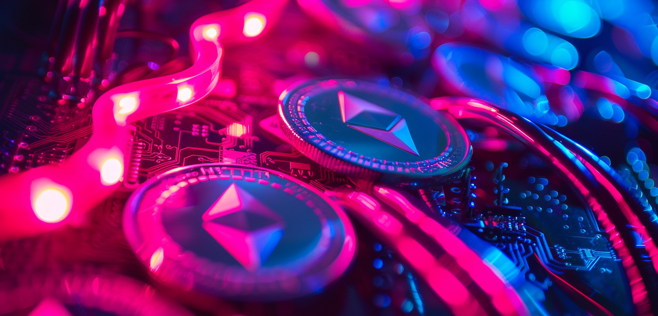 20 Jul 2024
20 Jul 2024Layer 2 Solutions: Scaling Ethereum and Beyond

Blockchain technology, epitomized by platforms like Ethereum, has revolutionized the way we think about decentralized applications and finance. However, as the popularity of these platforms has surged, so too have their scalability challenges. Ethereum, in particular, has faced significant issues with network congestion, high transaction fees, and slow processing times, especially during periods of high demand. These limitations have hindered the broader adoption and usability of blockchain technology.
To address these scalability challenges, Layer 2 solutions have emerged as a vital innovation. Layer 2 refers to technologies built on top of the existing blockchain (Layer 1) to improve its performance and efficiency without altering the underlying protocol. By offloading transactions and computation from the main chain, Layer 2 solutions can significantly increase transaction throughput, reduce costs, and enhance the overall user experience.

Understanding Layer 2 Solutions
Layer 2 solutions are technologies that operate on top of an existing blockchain (Layer 1) to enhance its scalability and efficiency. These solutions aim to handle transactions off the main blockchain, thus reducing the load and improving the performance of the primary network. By enabling faster and cheaper transactions, Layer 2 solutions play a crucial role in making blockchain technology more viable for widespread use.
How Layer 2 Solutions Differ from Layer 1
Layer 1 refers to the base layer of a blockchain, such as the Ethereum network itself. It handles all transactions and smart contracts directly on the blockchain, ensuring security and decentralization. However, Layer 1 solutions are often limited by their capacity to process transactions, leading to issues like high fees and slow transaction times during peak usage.
Layer 2 solutions, on the other hand, operate on top of Layer 1. They take transactions off the main chain and process them separately before recording the final state back on the main blockchain. This approach alleviates congestion on the main chain and allows for much higher transaction throughput.
Core Principles of Layer 2 Technologies
Layer 2 solutions are designed to address the limitations of Layer 1 blockchains, providing enhanced performance and functionality.
- Scalability
Layer 2 solutions significantly increase the transaction capacity of the blockchain without compromising its security or decentralization. By handling a large volume of transactions off-chain, they ensure the main chain remains efficient and effective.
- Efficiency
Transactions processed via Layer 2 solutions are faster and cheaper. By reducing the computational load on the main chain, Layer 2 technologies can offer near-instant transaction finality and minimal transaction costs.
- Security
While transactions occur off-chain, the security of Layer 2 solutions is typically anchored to the underlying Layer 1 blockchain. This ensures that the decentralized and secure nature of the blockchain is maintained.
- Interoperability
Layer 2 solutions are designed to work seamlessly with the existing blockchain infrastructure. They can integrate with various dApps and smart contracts without requiring significant changes to the underlying Layer 1 protocol.
Understanding these core principles helps in appreciating how Layer 2 solutions enhance the functionality and performance of blockchain networks, paving the way for broader adoption and more complex applications.

Types of Layer 2 Solutions
Layer 2 solutions come in various forms, each with its unique approach to enhancing blockchain scalability and efficiency. Below, we explore some of the most prominent types of Layer 2 solutions: State Channels, Plasma, Rollups, and Sidechains.
State Channels
State channels are a Layer 2 scaling solution that enables multiple transactions to occur off-chain between parties. By opening a state channel, participants can conduct an unlimited number of transactions off the main blockchain. Only the opening and closing of the channel are recorded on the blockchain, reducing the need for on-chain transaction processing.
Benefits
- Speed: Transactions are instant as they occur off-chain.
- Cost: Reduced transaction fees since fewer transactions are recorded on-chain.
- Privacy: Off-chain transactions are not publicly visible, enhancing privacy.
Use Cases
- Microtransactions in gaming and digital services.
- Repeated transactions between trusted parties, such as payment for subscription services.
Examples: Lightning Network (Bitcoin), Raiden Network (Ethereum)
- Lightning Network (Bitcoin)
A state channel network designed to facilitate faster and cheaper transactions on the Bitcoin blockchain.
- Raiden Network (Ethereum)
Similar to the Lightning Network, Raiden facilitates off-chain transfers of ERC-20 tokens on the Ethereum blockchain.
Plasma
Plasma is a framework for creating scalable applications using child chains that run alongside the main Ethereum blockchain. These child chains operate independently but periodically report their state to the main chain, ensuring security and integrity.
Benefits:
- Scalability: Handles a large number of transactions off-chain.
- Security: Inherits the security of the main Ethereum chain.
- Flexibility: Supports various applications and use cases.
Use Cases:
- High-throughput applications like decentralized exchanges (DEXs).
- Enterprise blockchain solutions requiring secure and scalable infrastructure.
Examples: OmiseGO, Matic Network
-
OmiseGO: A financial technology platform using Plasma to enable fast and secure financial transactions.
-
Matic Network (Polygon): A Layer 2 solution leveraging Plasma to provide scalable and instant blockchain transactions.
Rollups
Rollups aggregate multiple transactions into a single batch and submit them to the main chain, significantly reducing on-chain data size. There are two main types:
- Optimistic Rollups
Assume transactions are valid and only run computations in case of a dispute.
- ZK-Rollups (Zero-Knowledge Rollups)
Use zero-knowledge proofs to validate transactions off-chain and submit a single proof to the main chain.
By processing most transactions off-chain and only recording minimal data on-chain, rollups significantly increase transaction throughput and reduce costs.
Examples: Optimism, zkSync
- Optimism: An optimistic rollup solution enhancing Ethereum's scalability.
- zkSync: A zk-rollup solution providing fast and secure off-chain transactions.
Sidechains
Sidechains are separate blockchains that run parallel to the main chain and are interoperable with it. Assets can move between the main chain and the sidechain, allowing for more complex and scalable applications.
Benefits:
- Scalability: Independent blockchains can handle a high volume of transactions.
- Customization: Sidechains can be tailored to specific use cases and performance requirements.
Use Cases:
- Custom blockchain applications needing specific features not available on the main chain.
- High-frequency trading and gaming platforms requiring fast transaction processing.
Examples: Polygon (formerly Matic), xDai
- Polygon (formerly Matic): A well-known sidechain offering scalable and secure blockchain infrastructure.
- xDai: A stablecoin-focused sidechain designed for fast and low-cost transactions.
These Layer 2 solutions provide various methods to overcome the scalability limitations of Layer 1 blockchains, offering enhanced performance, lower costs, and greater usability for a wide range of applications.

Advantages of Layer 2 Solutions
Layer 2 solutions offer several significant advantages that enhance the functionality and usability of blockchain networks.
Scalability Improvements
Layer 2 solutions process a large volume of transactions off the main blockchain, significantly increasing the transaction throughput. By aggregating multiple transactions into a single batch or operating through sidechains, Layer 2 solutions relieve the main chain from processing every single transaction.
Impact on Network Congestion and Fees
By offloading transactions from the main chain, Layer 2 solutions reduce network congestion, leading to lower transaction fees and faster processing times. This scalability ensures that the blockchain can handle more users and transactions without compromising performance.
Cost Efficiency
Layer 2 solutions significantly reduce the transaction costs associated with blockchain networks. By minimizing the number of on-chain transactions, users can benefit from much lower fees compared to conducting all transactions directly on the Layer 1 blockchain.
Examples of Cost Savings from Layer 2 Adoption
- Polygon (formerly Matic): By using Polygon, Ethereum users experience significantly lower transaction fees while maintaining security.
- zkSync: This zk-rollup solution offers near-zero transaction fees, making it cost-effective for microtransactions and frequent trades.
Enhanced User Experience
Layer 2 solutions significantly improve the overall user experience by making transactions faster and more cost-effective.
Faster Transaction Confirmation Times
Layer 2 solutions offer near-instant transaction confirmation times by processing transactions off-chain and only recording the final state on the main blockchain. This rapid confirmation enhances the user experience, making blockchain applications more responsive.
Improved Usability for Decentralized Applications (dApps)
With reduced costs and faster transactions, Layer 2 solutions make decentralized applications more user-friendly and accessible. This improvement encourages wider adoption and more innovative use cases for dApps, as users can interact with these applications seamlessly and affordably.
These advantages highlight the transformative potential of Layer 2 solutions in addressing the scalability and usability challenges faced by Layer 1 blockchains. By enhancing scalability, reducing costs, and improving the user experience, Layer 2 solutions pave the way for broader adoption and more diverse applications of blockchain technology.

Challenges and Considerations
While Layer 2 solutions offer numerous benefits, they also present specific challenges and considerations that need to be addressed to ensure their successful implementation and adoption.
Security Concerns
Layer 2 solutions, while improving scalability and efficiency, can introduce potential security risks. These risks include vulnerabilities in the off-chain components, possible exploits in the bridging mechanisms between Layer 1 and Layer 2, and the reliance on the security model of the underlying blockchain.
Measures to Ensure Security and Trustworthiness
To mitigate these risks, several measures can be implemented:
- Regular Audits
Conducting frequent security audits of Layer 2 protocols and smart contracts to identify and rectify vulnerabilities.
- Bug Bounty Programs
Encouraging white-hat hackers to find and report security flaws through incentive programs.
- Strong Cryptographic Techniques
Utilizing robust cryptographic methods to secure off-chain transactions and ensure the integrity of data.
Complexity and Usability
The implementation and usage of Layer 2 solutions can be complex. Challenges include the need for significant technical expertise to deploy these solutions, potential difficulties in integrating with existing blockchain infrastructure, and the learning curve for users and developers.
Efforts to Improve User Interfaces and Developer Tools
To overcome these challenges, efforts are being made to simplify the deployment and usage of Layer 2 solutions:
- Enhanced User Interfaces
Developing more intuitive and user-friendly interfaces for interacting with Layer 2 protocols.
- Developer Tools and Documentation
Providing comprehensive tools, SDKs, and documentation to aid developers in building and integrating Layer 2 solutions.
- Education and Support
Offering training, tutorials, and support to help users and developers understand and effectively use Layer 2 technologies.
Interoperability
Seamless interoperability between Layer 1 and Layer 2 is crucial for the effective functioning of the blockchain ecosystem. Ensuring compatibility involves:
- Standardized Protocols
Developing and adopting standardized protocols that facilitate smooth interaction between Layer 1 and Layer 2.
- Secure Bridging Mechanisms
Implementing secure and efficient mechanisms for transferring assets and data between layers.
Cross-Chain Interoperability Considerations
In addition to Layer 1 and Layer 2 interoperability, cross-chain interoperability is essential for the broader blockchain landscape. Considerations include:
- Cross-Chain Bridges
Building bridges that allow assets and data to move between different blockchains.
- Interoperability Standards
Developing universal standards that ensure different blockchains and Layer 2 solutions can interact seamlessly.
- Collaborative Ecosystem
Fostering collaboration among different blockchain projects to create an interconnected and interoperable ecosystem.
By addressing these challenges and considerations, the blockchain community can ensure that Layer 2 solutions are secure, user-friendly, and interoperable, paving the way for their widespread adoption and impact.

Real-World Applications and Case Studies
Layer 2 solutions are being applied across various sectors, enhancing scalability and efficiency for numerous blockchain applications. Here, we explore their impact on decentralized finance (DeFi), non-fungible tokens (NFTs) and gaming, and enterprise solutions.
DeFi
Layer 2 solutions significantly improve the performance and user experience of DeFi platforms by increasing transaction throughput, reducing fees, and enabling faster transaction times. This allows DeFi platforms to handle a larger number of users and transactions without compromising on decentralization and security.
Case Studies of DeFi Projects Leveraging Layer 2 Technologies
- Uniswap
By integrating with Layer 2 solutions like Optimism, Uniswap has reduced gas fees and transaction times, making decentralized trading more accessible and efficient for users.
- Aave
Aave has explored using Layer 2 solutions to enhance its lending and borrowing platform, offering users quicker transactions and lower fees.
NFTs and Gaming
Layer 2 solutions are crucial for scaling NFT platforms and blockchain-based games, where high transaction volumes and user interactions can strain Layer 1 blockchains. By offloading transactions to Layer 2, these platforms can provide a smoother and more cost-effective user experience.
Examples of Successful Implementations in the Gaming Industry
- Axie Infinity
This popular blockchain-based game uses Ronin, a custom sidechain, to handle its high transaction volumes efficiently, reducing fees and improving gameplay experience.
- Immutable X
A Layer 2 solution for NFTs built on Ethereum, Immutable X offers gas-free transactions and high throughput, making it ideal for gaming and NFT marketplaces.
Enterprise Solutions
Enterprises are adopting Layer 2 solutions to enhance the scalability and efficiency of their blockchain applications. These solutions help enterprises manage large-scale transactions and data processing without the high costs and latency associated with Layer 1 blockchains.
Case Studies of Enterprises Benefiting from Layer 2 Scalability
- IBM Food Trust
By utilizing Layer 2 solutions, IBM Food Trust can handle the vast amounts of data required for tracking and tracing food products across the supply chain, ensuring transparency and efficiency.
- Microsof
Microsoft has integrated Layer 2 technologies into its blockchain-as-a-service (BaaS) offerings, providing clients with scalable and cost-effective blockchain solutions for various enterprise applications.
These case studies demonstrate the practical benefits and diverse applications of Layer 2 solutions, highlighting their critical role in the ongoing evolution and adoption of blockchain technology across different sectors.

Future Trends and Developments
Layer 2 solutions are continually evolving, with numerous innovations and advancements on the horizon. These developments promise to enhance the scalability, efficiency, and usability of blockchain technology even further.
Evolving Layer 2 Technologies
Innovations in Layer 2 solutions are rapidly advancing, introducing new ways to scale and optimize blockchain networks. Emerging projects like Arbitrum, StarkNet, and Loopring are pushing the boundaries of what Layer 2 technologies can achieve, offering higher throughput, lower costs, and improved user experiences. These projects are expected to have a significant impact on the broader adoption and functionality of blockchain technology.
Integration with Ethereum 2.0
As Ethereum transitions to Ethereum 2.0, Layer 2 solutions will play a crucial role in complementing this upgrade. Ethereum 2.0 aims to improve scalability and security through sharding, and Layer 2 solutions can enhance these benefits by offloading transactions and computation. The synergy between Layer 2 technologies and Ethereum's sharding model will create a more scalable and efficient blockchain ecosystem, capable of supporting a wide range of applications.
Broadening Beyond Ethereum
While Ethereum has been the primary focus of Layer 2 solutions, these technologies are beginning to be adopted by other blockchain networks. Projects like Polkadot, Binance Smart Chain, and Solana are exploring Layer 2 solutions to enhance their scalability and efficiency. Additionally, there is growing potential for cross-chain Layer 2 solutions that enable seamless interoperability between different blockchains, further expanding the utility and reach of these technologies.
Layer 2 solutions are integral to the future of blockchain scalability, offering transformative potential in enhancing blockchain usability and adoption. By addressing key challenges such as transaction throughput, cost efficiency, and user experience, Layer 2 technologies pave the way for more scalable, efficient, and accessible blockchain networks. As these solutions continue to evolve and integrate with advancements like Ethereum 2.0 and cross-chain interoperability, their role in the broader blockchain ecosystem will become increasingly vital, driving the next wave of innovation and adoption in decentralized technologies.

 Get RateX Pro
Get RateX Pro
 06 Jun 2024
06 Jun 2024



